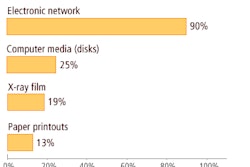PROVIDENCE, RI - The role of imaging informatics in the healthcare delivery system is evolving, and the future will be characterized by trends such as an increased emphasis on continuous process improvement and a new, more defined role for regional health information organizations (RHIOs), according to John Glaser, Ph.D., vice president and CIO of Partners Healthcare Systems in Boston.
"We're entering an era in which we will shift from this extraordinary focus of putting these (systems) in, and attention will shift to ... going after processes, trying to understand how to leverage the data, and extending systems," Glaser said.
Glaser was the keynote speaker during Thursday's opening general session of the annual meeting of the Society for Imaging Informatics in Medicine (SIIM)
Institutions today are increasingly adopting electronic health records (EHRs) technology, with estimates that more than two-thirds of hospitals have fully or partially implemented systems. After adoption, facilities will go through a period of examining process change or transformation, Glaser said.
Strategic value, in which an organization is materially better off after the investment, can be accrued in large doses of small and medium-sized gains, he said. Leveraging data accumulated through IT will also allow for pursuit of areas such as "pharmaco-vigilance," or support of research into the genomic bases of disease, according to Glaser.
It's no longer enough just to invest in IT to secure a competitive advantage, Glaser said.
"Frankly, there's nothing in the way of technology that you can acquire that will distinguish you from anybody that you worry about," he said. "What can distinguish you is the degree in which you leverage process, and if you're smarter about that, and to the degree in which you affect clinical collaboration, etc."
RHIO 2.0
RHIOs today are facing a challenge in achieving financial sustainability, with a very low percentage of organizations achieving break-even financial status so far, Glaser said.
"Of the 250 efforts under way across the U.S., I expect that 70% to 80% will fail within the next three years," he said.
In the next stage of RHIOs, in which Glaser calls RHIO 2.0, the majority of clinical data exchange will be the result of targeted initiatives that have very specific goals. Organizations will decide to effect interoperability when a business case can be made for it, Glaser said.
One technology that will find an increasing role in healthcare IT is service-oriented architecture (SOA), Glaser said.
"The view of an application as a monolithic block of code increasingly is an inappropriate way to view it," he said. "We now think about applications as collection of pieces of code; there's a piece to identify the patient, there's a piece to look at a result, etc. Something like an EMR is a collection of pieces that come together, not in an arbitrary fashion, but in a quasi-arbitrary fashion."
Applications can then be broken down into services and managed in that manner, Glaser said. The use of logic and clinical decision support tools will also be prominent, he said.
"With the growing advent of personal medicine, I expect this will become even more potent," Glaser said.
In other trends, senior hospital leaders are becoming increasingly comfortable and more sophisticated with the IT conversation, Glaser said. As a result, the discussion of value will be sharper -- and tolerance of IT performance problems reduced.
IT strategy is also becoming less of a development of a five-year plan, and more of a creation of an ongoing strategy process, Glaser said.
By Erik L. Ridley
AuntMinnie.com staff writer
June 7, 2007
Related Reading
PACS administrator certification program gets under way, May 30, 2007
Florida, DoD to develop HIT exchange, April 6, 2007
Regulatory carve-outs hope to spur HIT growth in U.S., February 28, 2007
Washington advocates healthcare information banks, December 6, 2006
Copyright © 2007 AuntMinnie.com



















